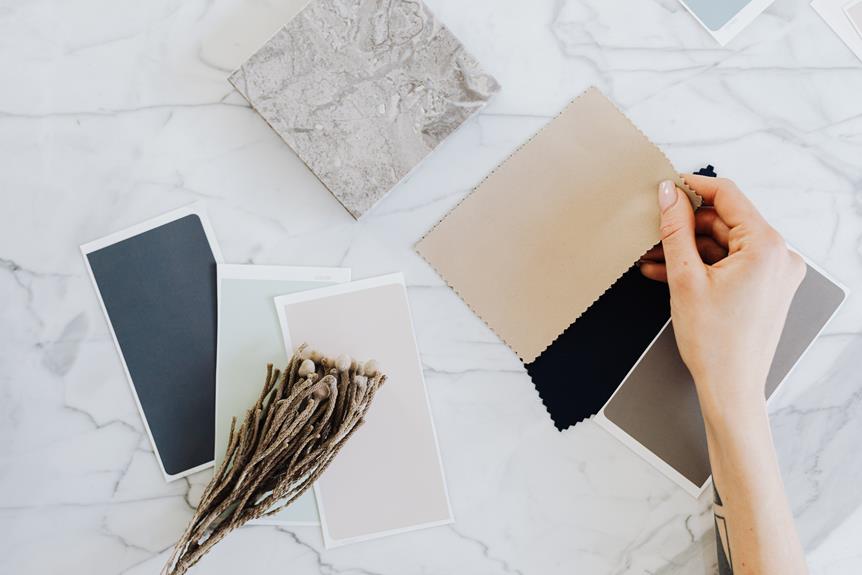Looking to tackle extreme temperatures in your DIY fabric projects? With the ability to withstand temperatures up to 200°F, heat resistant Velcro is a game-changer.
In this guide, we'll explore the top 5 heat resistant Velcro options for your projects, providing you with the knowledge to make an informed choice.
Whether you're working on outdoor gear or industrial applications, understanding the capabilities of heat resistant Velcro is crucial.
Get ready to master the intricacies of heat resistant Velcro and take your fabric projects to the next level.
Key Takeaways
- Heat resistant Velcro can withstand temperatures up to 200°F and is suitable for industrial settings where heat resistance is crucial.
- Material composition, precise choice of materials, and polished surface finish impact the durability and heat resistance of Velcro.
- Prolonged exposure to high temperatures can weaken and degrade heat resistant Velcro, so it has limitations despite its ability to withstand higher temperatures.
- Testing heat resistance in extreme conditions, with temperatures ranging from 150°F to 300°F, is essential to evaluate the performance of Velcro.
Understanding Heat Resistant Velcro
When using heat resistant Velcro, understanding its capabilities and limitations is essential for ensuring successful and durable fabric projects.
Heat resistant Velcro is designed to withstand high temperatures, making it suitable for various industrial settings where heat resistance is crucial. Its thermal performance is a key feature, ensuring that it remains functional and reliable even in extreme temperature conditions.
This type of Velcro also offers excellent chemical resistance, allowing it to withstand exposure to different chemicals without deteriorating.
Understanding the durability of heat resistant Velcro is important for selecting the right type for your specific project needs. It's essential to consider the intended application and the level of heat resistance required to ensure optimal performance.
Whether you're working on DIY fabric projects or industrial applications, having a clear understanding of the capabilities and limitations of heat resistant Velcro will contribute to the success and longevity of your endeavors.
Factors Affecting Velcro Performance
You must consider the impact of material composition on Velcro performance and its ability to withstand extreme temperatures.
Exposure to high temps can also significantly affect the durability and functionality of heat resistant Velcro.
These factors play a crucial role in determining the overall performance and reliability of the Velcro in your DIY fabric projects.
Material Composition Impact
The material composition of heat resistant Velcro significantly impacts its performance in extreme temperatures. When considering the material composition impact, several factors come into play:
- Precise: The choice of materials for the hook and loop components must be precise to ensure durability and heat resistance.
- Neutral: The combination of materials should be neutral in its response to extreme temperatures to maintain consistent performance.
- Polished: The surface finish of the materials needs to be polished to withstand heat without compromising the integrity of the Velcro.
- Testing: Rigorous heat resistance testing is essential to validate the material composition's impact on durability and performance in extreme temperatures.
Understanding how the material composition affects heat resistant Velcro is crucial for ensuring its reliability in demanding conditions.
Exposure to High Temps
As heat resistance is crucial for Velcro's performance in extreme temperatures, understanding the factors affecting its performance when exposed to high temps is essential. When considering heat resistant velcro usability, it's important to recognize that while heat resistant velcro can withstand higher temperatures than standard velcro, it still has limitations. The table below outlines the key factors affecting heat resistant velcro performance when exposed to high temps.
| Factors Affecting Performance | Description |
|---|---|
| Temperature | High temperatures can cause the velcro to weaken, reducing its holding strength. |
| Duration of Exposure | Prolonged exposure to high temps can accelerate the degradation of the velcro material. |
| Environmental Conditions | Factors such as humidity and direct sunlight can further impact the velcro's heat resistance. |
Understanding these factors will help you make informed decisions when using heat resistant velcro for your DIY fabric projects.
Testing Heat Resistance in Extreme Conditions
When testing heat resistance in extreme conditions, consider the durability and performance of the Velcro in high temperatures. It's important to subject the Velcro to a range of temperatures to ensure it can withstand extreme conditions. Here are some precise, neutral, and polished testing methods to evaluate heat resistance:
- Temperature range: Test the Velcro in temperatures ranging from 150°F to 300°F to assess its performance in extreme heat.
- Exposure duration: Expose the Velcro to high temperatures for extended periods to simulate prolonged use in extreme conditions.
- Physical stress: Apply pressure and tension to the Velcro while it's exposed to high temperatures to evaluate its durability under stress.
- Comparative analysis: Compare the heat resistance of the Velcro with standard Velcro under the same extreme conditions to gauge its performance.
Top 5 Picks for Heat Resistant Velcro
Consider these top 5 picks for heat resistant Velcro when tackling your DIY fabric projects in extreme temperatures.
- VELCRO Brand Industrial Strength Tape: This heavy-duty option is designed for maximum Velcro durability, making it ideal for high-stress applications. It offers exceptional temperature resistance, ensuring reliability in extreme heat.
- 3M Dual Lock Reclosable Fastener: Known for its robust adhesive properties, this Velcro alternative excels in temperature resistance. Its interlocking mushroom-shaped heads provide a strong, secure hold in hot environments.
- YKK Hook and Loop Fastening Tape: YKK is renowned for producing high-quality fastening solutions. Their heat resistant Velcro is engineered to withstand extreme temperatures, ensuring longevity and reliability.
- Velcro Extreme Outdoor Strips: Specifically designed for outdoor use, these Velcro strips offer exceptional temperature resistance. They're built to endure harsh weather conditions, making them suitable for outdoor fabric projects in extreme heat.
- Sew-On Velcro: For those seeking a traditional sewing option, sew-on Velcro provides reliable temperature resistance and durability. Its versatility makes it a great choice for various DIY fabric projects in extreme temperatures.
Velcro for High Temperature Applications
When choosing Velcro for high temperature applications, it's important to prioritize durability and heat resistance for your DIY fabric projects. Industrial applications and the aerospace industry often require Velcro that can withstand extreme temperatures. Here are some key factors to consider when selecting Velcro for high temperature applications:
- Material Composition: Look for Velcro made from heat-resistant materials such as aramid or silicone, as they offer excellent heat resistance and durability.
- Adhesive Strength: Ensure that the adhesive used on the Velcro is designed to withstand high temperatures without degrading, as this is crucial for maintaining a secure hold in extreme conditions.
- Testing and Certifications: Opt for Velcro that has been tested and certified for high temperature applications, as this provides assurance of its performance under extreme heat.
- Application Suitability: Consider the specific requirements of your DIY fabric project and select Velcro that's tailored to meet the high temperature demands of industrial applications and the aerospace industry.
When working with high temperature applications, it's essential to choose Velcro that not only meets but exceeds the heat resistance and durability needed for your DIY fabric projects.
Installation Tips for Heat Resistant Velcro
When installing heat resistant Velcro, it's crucial to ensure proper surface preparation for optimal adhesion.
Follow the recommended application temperature to guarantee the Velcro's effectiveness in extreme conditions.
These simple installation tips will help you make the most of your heat resistant Velcro for your DIY fabric projects.
Proper Surface Preparation
To ensure proper adhesion, thoroughly clean the surface before applying heat resistant Velcro to your DIY fabric projects. Follow these steps for successful installation:
- Surface Preparation: Wipe the surface with isopropyl alcohol to remove any dust, dirt, or oils that could hinder adhesion.
- Drying Time: Allow the surface to dry completely before applying the Velcro to ensure a strong bond.
- Positioning: Carefully align and mark the positions where the Velcro will be placed to ensure accurate placement.
- Firm Pressure: Apply firm and even pressure to the Velcro for at least 30 seconds to enhance the adhesive bonding.
Taking these precise steps will ensure a neutral and polished finish, allowing you to master the proper surface preparation for heat resistant Velcro installation.
Application Temperature Recommendations
Ensure optimal performance by applying heat resistant Velcro within the recommended temperature range for successful adhesion and longevity in your DIY fabric projects.
Before installation, verify the temperature limits specified by the manufacturer. Extreme cold or heat can affect the adhesive properties, potentially leading to detachment. Durability testing under various temperature conditions can offer insights into the Velcro's performance.
When applying the Velcro, ensure that the surface temperature falls within the recommended range. For most heat resistant Velcro, the optimal application temperature typically ranges from 70°F to 100°F. Avoid applying the Velcro in extreme temperatures, as this may compromise its adhesive strength.
Adhering to the recommended temperature guidelines will help guarantee a secure and long-lasting bond, crucial for the success of your fabric projects.
Benefits of Using Heat Resistant Velcro
Experience the convenience and durability of heat-resistant Velcro for securing fabrics in high-temperature environments. Using heat-resistant Velcro offers several advantages over alternative fastening methods, making it a versatile choice for fabric projects.
Here are the benefits of using heat-resistant Velcro:
- Precise: Heat-resistant Velcro provides a precise and secure closure, ensuring that your fabrics stay in place even in extreme temperatures.
- Neutral: The neutral color options available for heat-resistant Velcro allow for seamless integration into various fabric designs without being obtrusive.
- Polished: With its durable and polished design, heat-resistant Velcro maintains its effectiveness and appearance even after prolonged use in high-temperature settings.
- Versatility: Heat-resistant Velcro is versatile and can be used for a wide range of fabric projects, from DIY clothing repairs to industrial applications, offering a reliable fastening solution across different environments.
Maintenance and Care for Heat Resistant Velcro
Make sure to regularly brush off any debris or lint from the heat-resistant Velcro to maintain its effectiveness in extreme temperatures. Use a soft-bristled brush or a lint roller to gently remove any dirt or particles that may have accumulated on the Velcro surface.
Additionally, consider washing the Velcro with mild soap and water if it becomes heavily soiled, taking care to thoroughly dry it before use.
When storing heat-resistant Velcro, keep it in a cool, dry place away from direct sunlight and extreme temperatures. Avoid storing it near sources of heat or moisture, as these can compromise its long-term durability. Proper storage will help maintain the integrity of the Velcro over time.
In terms of long-term durability, following these cleaning instructions and storage tips can significantly extend the lifespan of heat-resistant Velcro, ensuring that it remains reliable in extreme temperatures. It's also worth noting that proper care and maintenance of Velcro can minimize its environmental impact by reducing the need for frequent replacements.
Frequently Asked Questions
Can Heat Resistant Velcro Be Used in Outdoor Applications?
Yes, heat-resistant Velcro can be used in outdoor applications. Its durability and performance in extreme temperatures make it suitable for various outdoor uses, providing a reliable fastening solution for your DIY fabric projects.
Is Heat Resistant Velcro Safe to Use in Contact With Food or in Food Processing Environments?
Yes, heat resistant Velcro is safe for food handling and food processing environments. It complies with safety regulations and maintains temperature resistance. Ensure material compatibility with food-grade standards for optimal use in these settings.
Can Heat Resistant Velcro Be Used in Industrial Settings With High Levels of Moisture or Humidity?
Yes, heat resistant Velcro can be used in industrial settings with high levels of moisture or humidity. It offers high temperature resistance, moisture and humidity resistance, and outdoor durability, making it suitable for various industrial applications.
How Does Heat Resistant Velcro Compare to Traditional Velcro in Terms of Strength and Durability?
Heat resistant Velcro offers comparable strength to traditional Velcro, with a focus on durability in extreme conditions. When assessing its durability, it's important to consider the intended application and the specific temperature range it will be exposed to.
Are There Any Specific Safety Precautions or Guidelines for Using Heat Resistant Velcro in Extreme Temperatures?
When using heat resistant Velcro in extreme temperatures, follow safety guidelines for outdoor use and industrial applications. Assess strength and durability for fabric projects. Consider moisture resistance for food safety and industrial use.
- Tetron Fabric for Marine Applications: Durability and Use Cases - June 18, 2025
- Tetron Fabric for Outdoor Furniture: Weather Resistance and Care - June 18, 2025
- Tetron Fabric for Wall Coverings: Style and Application Tips - June 18, 2025







